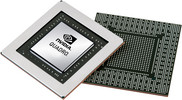NVIDIA Quadro P3000 vs NVIDIA Quadro P4000 Max-Q
NVIDIA Quadro P3000
► remove from comparison
The Nvidia Quadro P3000 is a mobile high-end workstation graphics card for notebooks. Similar to the consumer GeForce GTX 1060 (Laptop), it is based on the GP106 chip with 1280 shaders. The graphics card is designed for the Kaby Lake generation and is the successor to the Quadro M3000M (Maxwell). However, the P3000 is equipped with 6 GB GDDR5 video memory (at a lower bandwidth), while GTX 1060 is available with 3 or 6 GB. The clock rates range from 1088 MHz (base) to 1215 MHz (typical Boost) to 1240 MHz (max.).
The Quadro GPUs offer certified drivers, which are optimized for stability and performance in professional applications (CAD, DCC, medical, prospection, and visualizing applications). The performance in these areas is therefore much better compared to corresponding consumer GPUs.
Performance
The theoretical performance should be on par with the GTX 1060 (if the clocks did not take a massive hit), so the GPU should be significantly faster than the previous M3000M.
Power Consumption
The power consumption of the Quadro P3000 is 75 Watts TGP (including memory) or 55.3 W TDP according to Nvidia, so the card is suited for 15-inch notebooks or larger.
NVIDIA Quadro P4000 Max-Q
► remove from comparison
The Nvidia Quadro P4000 Max-Q (official Nvidia Quadro P4000 with Max-Q Design) is a mobile high-end workstation graphics card for notebooks. There is currently no consumer counterpart and the GPU is sitting between the Quadro P3000 (GTX 1060) and Quadro P5000 (GTX 1070). It is equipped with 1792 shaders and should therefore use the same GP104 chip from the P5000 (2048 shaders). The Max-Q version is a power efficient variant of the normal Quadro P4000 with lower clock rates (1113 - 1240 versus 1202 - ?) and a much reduced power consumption (80 versus 100 Watt TGP).
The Quadro GPUs offer certified drivers, which are optimized for stability and performance in professional applications (CAD, DCC, medical, prospection, and visualizing applications). The performance in these areas is therefore much better compared to corresponding consumer GPUs.
| NVIDIA Quadro P3000 | NVIDIA Quadro P4000 Max-Q | |||||||||||||||||||||||||||||||||||||||||||||||||||||||||||||||||||||||||||||||
| Quadro P Series |
|
| ||||||||||||||||||||||||||||||||||||||||||||||||||||||||||||||||||||||||||||||
| Codename | N17E-Q1 | N17E-Q3 Max-Q | ||||||||||||||||||||||||||||||||||||||||||||||||||||||||||||||||||||||||||||||
| Architecture | Pascal | Pascal | ||||||||||||||||||||||||||||||||||||||||||||||||||||||||||||||||||||||||||||||
| Pipelines | 1280 - unified | 1792 - unified | ||||||||||||||||||||||||||||||||||||||||||||||||||||||||||||||||||||||||||||||
| Core Speed | 1088 - 1215 (Boost) MHz | 1113 - 1240 (Boost) MHz | ||||||||||||||||||||||||||||||||||||||||||||||||||||||||||||||||||||||||||||||
| Memory Speed | 7008 MHz | 6006 MHz | ||||||||||||||||||||||||||||||||||||||||||||||||||||||||||||||||||||||||||||||
| Memory Bus Width | 192 Bit | 256 Bit | ||||||||||||||||||||||||||||||||||||||||||||||||||||||||||||||||||||||||||||||
| Memory Type | GDDR5 | GDDR5 | ||||||||||||||||||||||||||||||||||||||||||||||||||||||||||||||||||||||||||||||
| Max. Amount of Memory | 16 GB | 16 GB | ||||||||||||||||||||||||||||||||||||||||||||||||||||||||||||||||||||||||||||||
| Shared Memory | no | no | ||||||||||||||||||||||||||||||||||||||||||||||||||||||||||||||||||||||||||||||
| API | DirectX 12_1, Shader 5.0, OpenGL 4.5 | DirectX 12_1, Shader 5.0, OpenGL 4.5 | ||||||||||||||||||||||||||||||||||||||||||||||||||||||||||||||||||||||||||||||
| Power Consumption | 75 Watt | 80 Watt | ||||||||||||||||||||||||||||||||||||||||||||||||||||||||||||||||||||||||||||||
| technology | 16 nm | 16 nm | ||||||||||||||||||||||||||||||||||||||||||||||||||||||||||||||||||||||||||||||
| Features | Optimus, PhysX, 3D Vision Pro, nView, Optimus | Optimus, PhysX, 3D Vision Pro, nView, Optimus | ||||||||||||||||||||||||||||||||||||||||||||||||||||||||||||||||||||||||||||||
| Notebook Size | large | large | ||||||||||||||||||||||||||||||||||||||||||||||||||||||||||||||||||||||||||||||
| Date of Announcement | 11.01.2017 | 11.01.2017 | ||||||||||||||||||||||||||||||||||||||||||||||||||||||||||||||||||||||||||||||
| Link to Manufacturer Page | www.nvidia.com | www.nvidia.com |
Benchmarks
3DM Vant. Perf. total + NVIDIA Quadro P3000
specvp11 snx-01 + NVIDIA Quadro P3000
specvp12 sw-03 + NVIDIA Quadro P3000
Cinebench R15 OpenGL 64 Bit + NVIDIA Quadro P3000
GFXBench T-Rex HD Offscreen C24Z16 + NVIDIA Quadro P3000
Average Benchmarks NVIDIA Quadro P3000 → 100% n=22
Average Benchmarks NVIDIA Quadro P4000 Max-Q → 122% n=22
* Smaller numbers mean a higher performance
1 This benchmark is not used for the average calculation
Game Benchmarks
The following benchmarks stem from our benchmarks of review laptops. The performance depends on the used graphics memory, clock rate, processor, system settings, drivers, and operating systems. So the results don't have to be representative for all laptops with this GPU. For detailed information on the benchmark results, click on the fps number.

Ark Survival Evolved
2017
F1 2017
2017
Dirt 4
2017
Rocket League
2017
Prey
2017
For Honor
2017
Resident Evil 7
2017
Titanfall 2
2016
Battlefield 1
2016
Civilization 6
2016
Mafia 3
2016
Doom
2016
Rainbow Six Siege
2015
Just Cause 3
2015
Fallout 4
2015
Metal Gear Solid V
2015
The Witcher 3
2015
Dirt Rally
2015
Ryse: Son of Rome
2014
Alien: Isolation
2014
Thief
2014
Company of Heroes 2
2013
Metro: Last Light
2013
BioShock Infinite
2013
Batman: Arkham City
2011Average Gaming NVIDIA Quadro P3000 → 100%
Average Gaming 30-70 fps → 100%
Average Gaming NVIDIA Quadro P4000 Max-Q → 125%
Average Gaming 30-70 fps → 126%
| NVIDIA Quadro P3000 | NVIDIA Quadro P4000 Max-Q | |||||||||||||
|---|---|---|---|---|---|---|---|---|---|---|---|---|---|---|
| low | med. | high | ultra | QHD | 4K | low | med. | high | ultra | QHD | 4K | |||
| Ark Survival Evolved | 92 | 52 | 51 | 27 | 27 | |||||||||
| F1 2017 | 193 | 140 | 105 | 72 | 34 | |||||||||
| Dirt 4 | 220 | 164 | 93 | 55 | 34 | |||||||||
| Rocket League | 244 | 223 | 163 | |||||||||||
| Prey | 89.3 | 142 | 129 | 125 | 109 | 38 | ||||||||
| Resident Evil 7 | 354 | 195 | 161 | 135 | 60 | |||||||||
| Civilization 6 | 80 | 76 | 63 | 60 | 44 | |||||||||
| Mafia 3 | 36.5 | 84 | 104 | 43 | 17 | |||||||||
| Deus Ex Mankind Divided | 103.7 | 77.6 | 43.3 | 22.9 | 14.5 | 129 | 106 | 60 | 32 | 21 | ||||
| Doom | 73 | 130 | 121 | 97 | 92 | 35 | ||||||||
| Ashes of the Singularity | 52.5 | 47.8 | 76 | 67 | 62 | 26 | ||||||||
| Rise of the Tomb Raider | 176.4 | 107 | 59.4 | 52 | 21 | 176 | 144 | 77 | 65 | 28 | ||||
| Just Cause 3 | 140 | 133 | 89 | 77 | 35 | |||||||||
| Fallout 4 | 51.9 | 156 | 151 | 93 | 76 | 30 | ||||||||
| Call of Duty: Black Ops 3 | 145 | 133 | 85 | 82 | 32 | |||||||||
| Metal Gear Solid V | 60 | 60 | 60 | 60 | 60 | 50 | ||||||||
| Batman: Arkham Knight | 73 | 49 | 171 | 152 | 96 | 94 | 32 | |||||||
| The Witcher 3 | 167.2 | 103.6 | 63 | 33 | 21.8 | 162 | 119 | 79 | 42 | 29 | ||||
| Ryse: Son of Rome | 121 | 111 | 88 | 82 | ||||||||||
| Alien: Isolation | 250 | 212 | 192 | 148 | ||||||||||
| Middle-earth: Shadow of Mordor | 123 | 112 | 107 | 90 | ||||||||||
| Thief | 65 | 96 | 94 | 93 | 79 | |||||||||
| Batman: Arkham Origins | 330 | 270 | 177 | 82 | ||||||||||
| Company of Heroes 2 | 69 | 63 | 62 | 50 | ||||||||||
| Metro: Last Light | 67.5 | 129 | 79 | 78 | 84 | |||||||||
| BioShock Infinite | 262 | 223 | 209 | 97 | 256 | 218 | 202 | 113 | ||||||
| Batman: Arkham City | 195 | 170 | 144 | 106 | ||||||||||
| NVIDIA Quadro P3000 | NVIDIA Quadro P4000 Max-Q | |||||||||||||
| low | med. | high | ultra | QHD | 4K | low | med. | high | ultra | QHD | 4K | < 30 fps < 60 fps < 120 fps ≥ 120 fps | 1 3 | 1 3 1 | 4 2 1 | 1 4 6 | | 3 | < 30 fps < 60 fps < 120 fps ≥ 120 fps | 7 20 | 1 11 15 | 2 18 7 | 1 4 17 2 | | 6 10 1 |
For more games that might be playable and a list of all games and graphics cards visit our Gaming List























